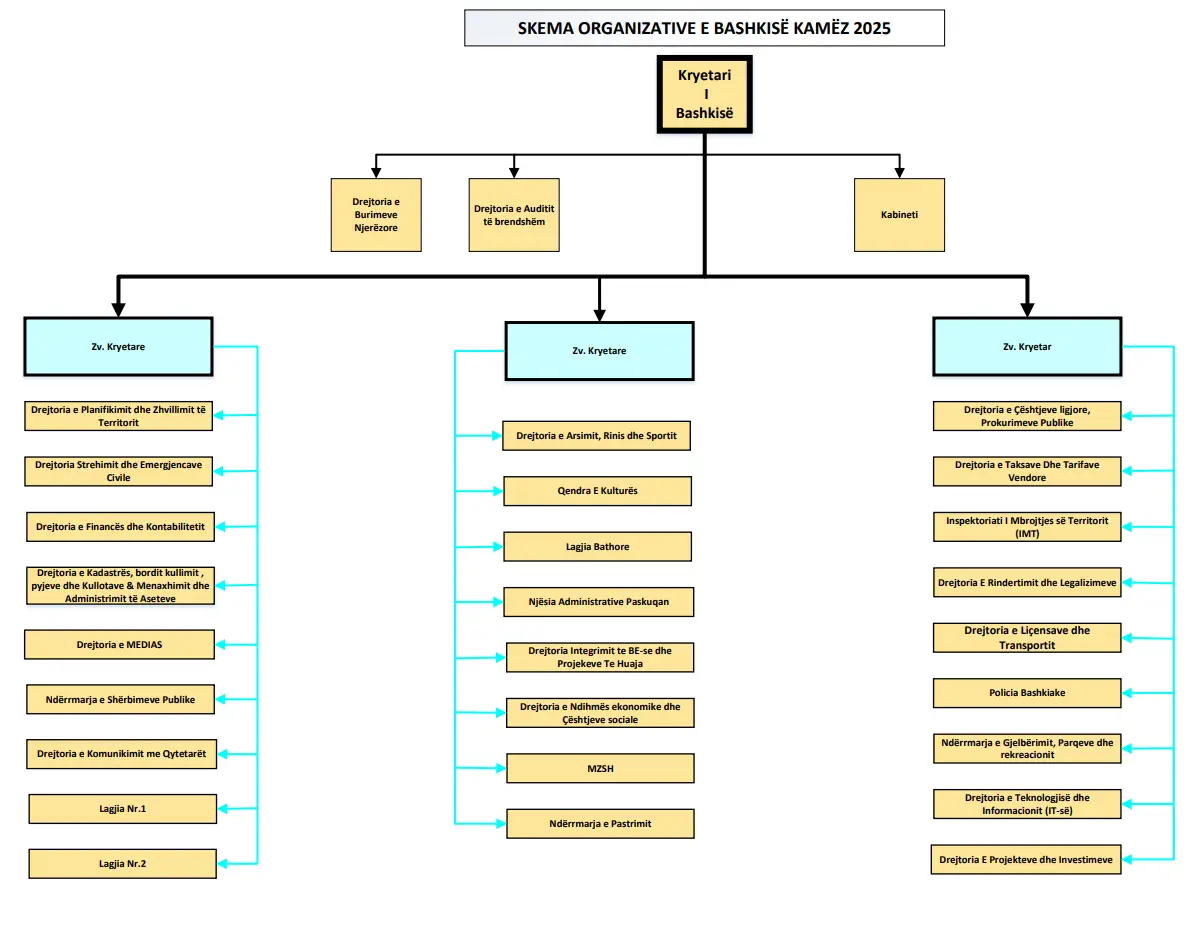Na kontaktoni
Open Data is a free and open interface for sharing information, where anyone can access data related to the city of Kamza. Whether you are a citizen, business owner, researcher, or developer, the platform provides information to help you better understand the city and develop solutions for the challenges of Kamza Municipality.
This portal aims to increase transparency and provides citizens with various data about jobs, investments, and every service carried out in the city at no cost. The data can be downloaded to electronic devices and later used for informational, research, academic, or journalistic purposes.
The information is easily accessible and continuously updated to ensure maximum transparency for citizens.
Information is no longer considered the exclusive right of the institution that creates it, but rather as a tool to be accessible and useful to citizens. On the other hand, the portal helps the municipality identify the city’s priorities and supports policymakers during the decision-making process.
Kamza is now a city in intensive development. The last 20 years have proven this, especially since 2007 to the present, Kamza has shown extraordinary progress. This progress is evident in all areas: population growth, infrastructure, state institutions, education, healthcare, culture, sports, etc. Likewise, the flourishing of free enterprise, with a tripling in the number of businesses, is an indicator of this city's vitality, which is growing day by day.
However, earlier, Kamza did not have the appearance it has today, but was a plain, which for most of the time was flooded by water and, as a result, was a not very populated area. 22 centuries ago, the lands of Kamza had Preza as its capital. Around 1250 AD, settlements in the Kamza area were around the banks of the Tirana and Tërkuza rivers, a period in which the owners of these lands were Tanush and Karl Topia. This region, at the time of the Turkish invasions, joined the Principality of Kastriots. In the four sieges of Kruja, 1450-1478, Kamza was burned and many farmers were taken prisoner by Sultan Murat II and (his son) Mehmet II.
Around 1431 the name Kamza comes to light. There are two stories that tell the origin of the name Kamza
The name Kamza was born around 1430. Evidence that has been found to this day claims that there were many wild olive trees in the lands of Kamza. Sprouts called kamza olives grew around the trunk, and for this reason the lands between the Tirana and Tërkuza rivers were called Kamza.
In 1431, the name Kamza appeared, which still has no authorship, but according to tradition, when an old woman was spinning wool, passersby asked her: “What are you doing, my mother?” The woman replied: “I am knitting in kamza”. This is how it is thought that the name stuck, which has not changed even today, but has taken on other dimensions.
In 1700, the number of houses with villagers coming down from the highlands began to increase.
At this time, Kamza began to be viewed with greedy eyes to make it their property. The claimants were the great tribes of the Bushatllinj of Shkodra and Ahmet Kurt Pasha of Berat.
For a period of 70 years, they waged wars among themselves, but in the end, no one won. During this period, Kamza was greatly ruined.
Kamza had a rural administrative status, a commune, until 1996. In that year, due to demographic, socio-economic and urban developments, it was transformed into a local administrative unit with the status of a first-level municipality. Kamza, as a first-level local administrative unit, is administratively divided into: the Urban Center (city), the Bathore Administrative Unit and 5 rural administrative divisions: Valias, Laknas, Frutikulturë, Zall-Mner and Bulçesh. The democratic changes after 1990 allowed a massive migration of citizens from all over the country to the main cities. This phenomenon also affected Kamza, where many residents from the north and northeast of Albania moved to this area.
1991-1992, the population increased from 12,500 to 20,000 inhabitants
1992-1996, the population increased to 45,000 inhabitants
From 1997-2002, the population reached 53,027 inhabitants
From 2002-2011, the population reached 90,000 inhabitants
The average age of the population is 27 years, more than a third is under the age of 15 and 62% of the rest belong to the age group 14-60 years.
The third age accounts for 8%.
The number of families in Kamza reaches approximately 20,000.
The birth-death ratio is 5:1.
All major religious faiths are present: Muslim, Catholic, Orthodox and institutions of worship, church and mosque. Today, Kamza, due to demographic growth, has become one of the six largest municipalities in the country, which continues to undergo comprehensive changes and at very high rates.
This online tool informs the public about the Municipality's annual revenues, expenditures and investments, as well as the calculation of annual taxes and fees for citizens and businesses.
The implementation of the Medium-Term Budget Program is an important instrument for improving the quality of life, improving access, territorial integration and equality in services, sustainable economic development, increasing the quality of life, and protecting the environment.
Transparency and accountability are linked to each other, with transparency of local government authorities representing a first step towards holding local elected officials accountable and building trust with the community.
Information on the structures and organization of the administration of the Kamëz Municipality.

Environmental Impact Assessment Report
Review of the Local General Plan
Decision
SEA Notice
NOTICE
Application for updating the General Plan
Application for a building permit for new constructions or additions with a total area of up to 250m2 near Local Government Units